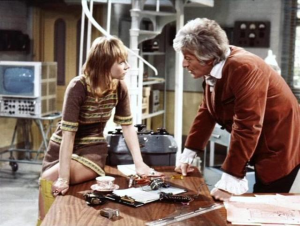I’m going to level with you straight up – this post isn’t going to have a lot of archaeological or academic content (except inasmuch as Lovecraft’s stories themselves are intrinsically archaeological and scholarly in character), so if that’s what you come here for you might want to sit it out and wait for the next one.
 The original run of Doctor Who last more than quarter of a century from 1963 to 1989 and in that time the good Doctor fought everything from the well-known Daleks and Cybermen to the more eccentric – robots made of sweets, gigantic prawn-viruses, rubber-clad men with aerials on their heads, and so on. More than once he’s come up against ancient, unknowable evils ‘Eeeevil, evilsincethedawnoftime!’ as Sylvester McCoy’s seventh Doctor once put it (unfortunately the clip doesn’t seem to be up online anywhere), and especially in the 70s, he’s also seen his fair share of sinister cultists. These are, of course, staples of the works of H. P. Lovecraft, and you’d expect a fair bit of overlap between the kinds of people who read his stories and those who watch and write for Doctor Who.
The original run of Doctor Who last more than quarter of a century from 1963 to 1989 and in that time the good Doctor fought everything from the well-known Daleks and Cybermen to the more eccentric – robots made of sweets, gigantic prawn-viruses, rubber-clad men with aerials on their heads, and so on. More than once he’s come up against ancient, unknowable evils ‘Eeeevil, evilsincethedawnoftime!’ as Sylvester McCoy’s seventh Doctor once put it (unfortunately the clip doesn’t seem to be up online anywhere), and especially in the 70s, he’s also seen his fair share of sinister cultists. These are, of course, staples of the works of H. P. Lovecraft, and you’d expect a fair bit of overlap between the kinds of people who read his stories and those who watch and write for Doctor Who.
Sure enough, once the series was cancelled and the Doctor’s ongoing adventures moved to a series of monthly original novels for the 1990s, some of the fans writing these books tried to forge explicit connections between the cults and formless evils of the old days and the handily out-of-copyright Lovecraftian Cthulhu mythos. There had been a universe before this one, a couple of stories said, and it had its own physical laws and its own equivalent of the Time Lords, the Doctor’s powerful race of time-travellers. When that universe ended, a few of them found ways to survive and emerge into our own, where they acquired previously undreamt-of powers. These became the Great Old Ones, and a number of the Doctor’s old foes were among their numbers. It’s a bit of a silly retcon, of course, an unnecessary link between two bodies of work almost diametrically opposed in their values, attitudes and approaches. But on the other hand, it is kind of fun, and part of Doctor Who’s raison d’etre is mashing itself up with things that don’t quite fit.
So with this in mind, let’s go for a whistle-stop tour through time and see just how Lovecraftian original-flavour Doctor Who could be.
Continue reading →




 The original run of Doctor Who last more than quarter of a century from 1963 to 1989 and in that time the good Doctor fought everything from the well-known Daleks and Cybermen to the more eccentric – robots made of sweets, gigantic prawn-viruses, rubber-clad men with aerials on their heads, and so on. More than once he’s come up against ancient, unknowable evils ‘Eeeevil, evilsincethedawnoftime!’ as Sylvester McCoy’s seventh Doctor once put it (unfortunately the clip doesn’t seem to be up online anywhere), and especially in the 70s, he’s also seen his fair share of sinister cultists. These are, of course, staples of the works of H. P. Lovecraft, and you’d expect a fair bit of overlap between the kinds of people who read his stories and those who watch and write for Doctor Who.
The original run of Doctor Who last more than quarter of a century from 1963 to 1989 and in that time the good Doctor fought everything from the well-known Daleks and Cybermen to the more eccentric – robots made of sweets, gigantic prawn-viruses, rubber-clad men with aerials on their heads, and so on. More than once he’s come up against ancient, unknowable evils ‘Eeeevil, evilsincethedawnoftime!’ as Sylvester McCoy’s seventh Doctor once put it (unfortunately the clip doesn’t seem to be up online anywhere), and especially in the 70s, he’s also seen his fair share of sinister cultists. These are, of course, staples of the works of H. P. Lovecraft, and you’d expect a fair bit of overlap between the kinds of people who read his stories and those who watch and write for Doctor Who.

